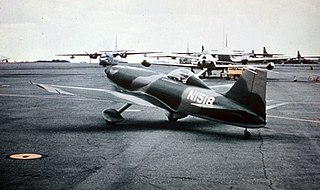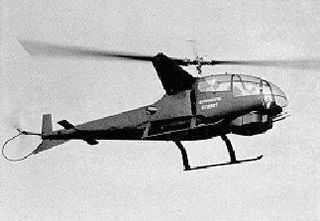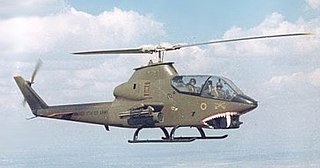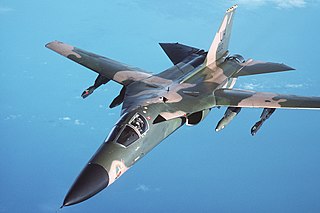 W
WThe American Electric Piranha was a prototype American counter-insurgency aircraft. Designed by Milt Blair and Dick Ennis in the early 1960s, it was built by the American Electric Corporation.
 W
WThe Bell 207 Sioux Scout was a modified Bell 47 helicopter, developed by Bell Helicopter under contract from the United States Army, as a proof-of-concept demonstrator for the Bell D-255 helicopter gunship design, featuring a tandem cockpit, stub wings, and a chin-mounted gun turret.
 W
WThe Bell AH-1 Cobra is a two-blade rotor, single-engine attack helicopter manufactured by Bell Helicopter. It was developed using the engine, transmission and rotor system of the Bell UH-1 Iroquois. A member of the prolific Huey family, the AH-1 is also referred to as the HueyCobra or Snake.
 W
WThe Fairchild AC-119G Shadow and AC-119K Stinger were twin-engine piston-powered gunships developed by the United States during the Vietnam War. They replaced the Douglas AC-47 Spooky and operated alongside the early versions of the AC-130 Spectre gunship.
 W
WThe Cavalier Mustang was a post-World War II civilian-modified version of the North American P-51 Mustang aircraft. Although originally intended as a high speed personal aircraft, the Cavalier was also exported for use as a fighter and close air support aircraft to third-world air forces.
 W
WThe Cessna A-37 Dragonfly, or Super Tweet, is an American light attack aircraft developed from the T-37 Tweet basic trainer in the 1960s and 1970s by Cessna of Wichita, Kansas. The A-37 was introduced during the Vietnam War and remained in peacetime service afterward.
 W
WThis is a list of A-37B Dragonfly squadrons of the United States Air Force.
 W
WThe Convair Model 48 Charger was a prototype light attack and observation aircraft of the 1960s, developed to meet a requirement for a dedicated counter-insurgency (COIN) aircraft. It was a two-seat, twin-boom aircraft powered by two turboprop engines which lost out to the North American Rockwell OV-10 Bronco of similar layout. Only the single prototype Model 48 was built.
 W
WThe Douglas AC-47 Spooky was the first in a series of fixed-wing gunships developed by the United States Air Force during the Vietnam War. It was designed to provide more firepower than light and medium ground-attack aircraft in certain situations when ground forces called for close air support.
 W
WThe General Dynamics F-111 Aardvark is a retired American supersonic, medium-range interdictor and tactical attack aircraft that also filled the roles of strategic nuclear bomber, aerial reconnaissance, and electronic-warfare aircraft in its various versions. The word "aardvark" is Afrikaans for "earth pig" and reflects the look of the long nose of the aircraft that might remind one of the nose of the aardvark. Developed in the 1960s by General Dynamics, it entered service in 1967 with the United States Air Force. The Royal Australian Air Force (RAAF) also ordered the type and began operating F-111Cs in 1973.
 W
WThe General Dynamics F-111C is a variant of the F-111 Aardvark medium-range interdictor and tactical strike aircraft, developed by General Dynamics to meet Australian requirements. The design was based on the F-111A model but included longer wings and strengthened undercarriage. The Australian government ordered 24 F-111Cs to equip the Royal Australian Air Force (RAAF) in 1963, but the aircraft were not delivered until 1973 because of long-running technical problems. During 1979 and 1980 four of these aircraft were converted to the RF-111C reconnaissance variant. Four ex–United States Air Force (USAF) F-111As were purchased by Australia and converted to F-111C standard in 1982 to replace F-111Cs destroyed during accidents. Australia also operated 15 F-111Gs between 1993 and 2007, mainly for conversion training. The RAAF retired its remaining F-111Cs in December 2010. In Australian military and aviation circles, the F-111 Aardvark was affectionately known as the "Pig", due to its long snout and terrain-following ability.
 W
WThe Grumman A-6 Intruder is an American twinjet all-weather attack aircraft developed and manufactured by American aircraft company Grumman Aerospace that was operated by the U.S. Navy.
 W
WThe Hughes OH-6 Cayuse is a single-engine light helicopter with a four-bladed main rotor used for personnel transport, escort and attack missions, and observation. Hughes Helicopters also developed the Model 369 as a civilian helicopter, and the Hughes Model 500, currently produced by MD Helicopters as the MD 500.
 W
WThe Boeing MH-6M Little Bird and its attack variant AH-6, are light helicopters used for special operations in the United States Army. Originally based on a modified OH-6A, it was later based on the MD 500E, with a single five-bladed main rotor. The newest version, the MH-6M, is based on the MD 530F and has a single, six-bladed main rotor and four-bladed tail rotor.
 W
WThe Helio AU-24 Stallion was an American armed gunship, counter-insurgency, and utility transport developed for the United States Air Force. A total of 20 were built during the Vietnam War, with most of the aircraft being later sold to the Khmer Air Force.
 W
WThe Lockheed AC-130 gunship is a heavily armed, long-endurance, ground-attack variant of the C-130 Hercules transport, fixed-wing aircraft. It carries a wide array of ground attack weapons that are integrated with sophisticated sensors, navigation, and fire-control systems. Unlike other modern military fixed-wing aircraft, the AC-130 relies on visual targeting. Because its large profile and low operating altitudes of approximately 7,000 feet make it an easy target, its close air support missions are usually flown at night.
 W
WThe Lockheed AH-56 Cheyenne was an attack helicopter developed by Lockheed for the United States Army. It rose from the Army's Advanced Aerial Fire Support System (AAFSS) program to field the service's first dedicated attack helicopter. Lockheed designed the Cheyenne using a four-blade rigid-rotor system and configured the aircraft as a compound helicopter with low-mounted wings and a tail-mounted thrusting propeller driven by a General Electric T64 turboshaft engine. The Cheyenne was to have a high-speed dash capability to provide armed escort for the Army's transport helicopters, such as the Bell UH-1 Iroquois.
 W
WThe LTV A-7 Corsair II is a carrier-capable subsonic light attack aircraft designed and manufactured by American conglomerate Ling-Temco-Vought (LTV).
 W
WThe North American Rockwell OV-10 Bronco is an American twin-turboprop light attack and observation aircraft. It was developed in the 1960s as a special aircraft for counter-insurgency (COIN) combat, and one of its primary missions was as a forward air control (FAC) aircraft. It can carry up to 3,200 lb of external munitions, internal loads such as paratroopers or stretchers, and loiter for three or more hours.